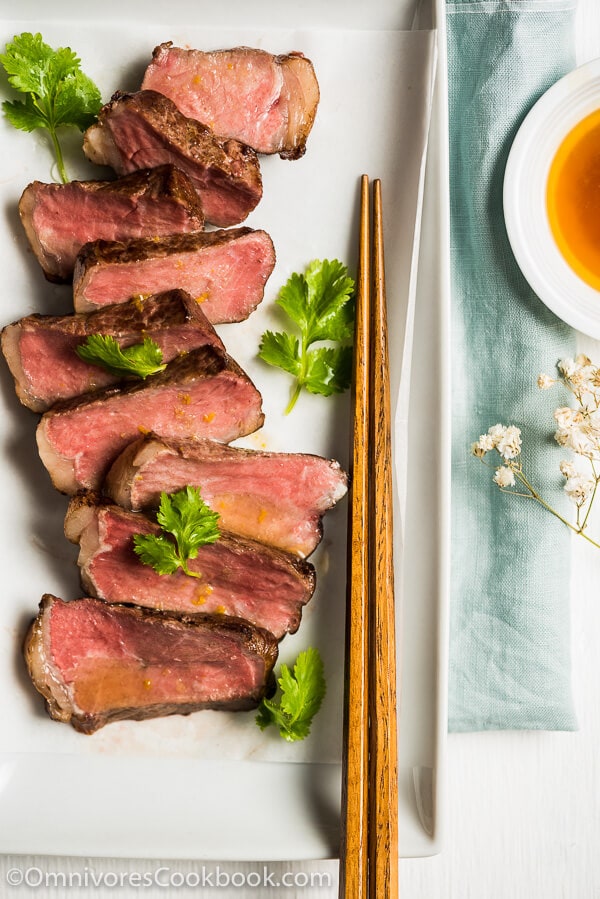
Sous vide steak yields perfect results every single time. This post introduces the easiest approach, in which the steak is cooked in the oven without special equipment.
Sous vide cooking is becoming very trendy these days. If you’re curious about the cooking method but do not want to invest in an expensive sous vide setup, this is the post for you!
What is sous vide?
In cooking sous vide, you seal the ingredients in a plastic bag and place the bag in a water bath that maintains the target temperature. The food will cook very slowly, until it reaches the target temperature. Then you take it out and finish it with a quick sear, by using a torch or deep-frying it.
Compared to traditional cooking methods, not only does this scientific approach yield very consistent and perfect results every time, it also generates much more evenly cooked meat.
To compare the two approaches, take a look at the images below.
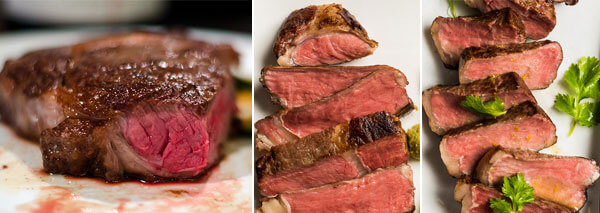
On the left side is the steak I cooked using a traditional method – I seared it in a hot pan to brown the steak first, then finished it in the oven until medium rare. As you can see, a very thick part of the outer layer is cooked to well-done, while the core of the steak remains very bloody.
The pictures in the middle and on the right are cooked using the concepts of sous vide (you can read more about this below) without the water bath setup. As you can see, the interior of the steak is perfectly cooked to an even color (middle – medium rare; right – medium), with a very thin crust of cooked-through meat.
How to achieve sous vide cooking without a water bath setup
I recently ventured into sous vide cooking, thanks to a fabulous book – Modernist Cuisine At Home. It’s the home cook’s version of Modernist Cuisine, which allows you to experiment with new cooking concepts using the equipment you already have in the kitchen.
The book introduces a few approaches to creating a perfect sous vide steak at home:
- The original way: purchase a water oven with the sous vide setup. Seal the steak in a plastic bag with a thermometer inserted into it. Slow cook it in a warm water bath until it reaches the desired core temperature, then sear the surface. Finish with a blowtorch or by deep-frying.
- Sous vide in a cooler: instead of using an expensive equipment rig, you can use your regular old cooler, filled with hot water (within a few degrees of a set temperature). Slow cook the steak by following the same logic above. Finish with a blowtorch or by deep-frying.
- Sous vide on a charcoal grill: Freeze the outer layer of the steak. Sear it over direct heat on the grill to brown it. Place a pan filled with ice under the grilling rack, on the other side of the grill. Place a sliced onion on the rack and place the steak on top of it. This setup creates a very gentle indirect heat, so the meat will cook slowly until reaching the desired temperature.
- {Used in this recipe} Sous vide in the oven: freeze the outer layer of the steak and sear it in a hot pan (so the steak will be browned without being overcooked). Cook the steak in the oven at the lowest temperature setting until it reaches desired doneness.
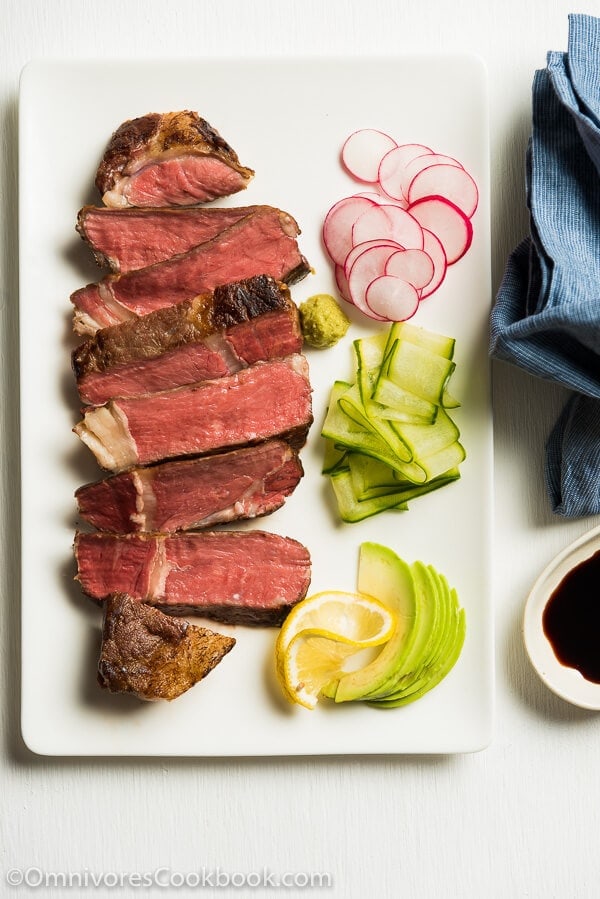
After a quick read-through, you can see that the last approach is the easiest. This method is almost identical to the traditional way, only with a very low oven temperature and a longer oven time.
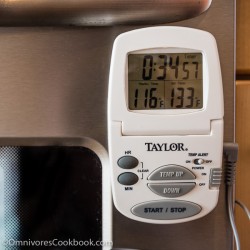
The only special equipment required in the recipe is a digital thermometer with an oven-safe probe. If you often smoke meat, you probably already own one. If not, I highly recommend you invest 20 dollars to get one for your kitchen. It’s not just for sous vide cooking – it comes in handy when roasting meat, cooking fish, or even boiling water. It has an alarm to remind you when the food has reached the set temperature. You’ll never need to open the oven door multiple times when roasting a large piece of beef, and the results will come out perfect every time.
Below are the target core temperatures you can use, depending on your cut of meat.
The core temperature chart of various cuts of beef
Ribeye: rare 54 C / 129 F; Medium rare 56 C / 133 F ; Pink 58 C / 136 F; Medium 60 C / 140 F
Strip steak: rare 52 C / 126 F; Medium rare 55 C / 131 F ; Pink 57 C / 135 F; Medium 62 C / 144 F
Filet: rare 50 C / 122 F; Medium rare 53 C / 127 F ; Pink 56 C / 133 F; Medium 62 C / 144 F
Flank: rare 54 C / 129 F; Medium rare 56 C / 133 F ; Pink 59 C / 138 F; Medium 62 C / 144 F
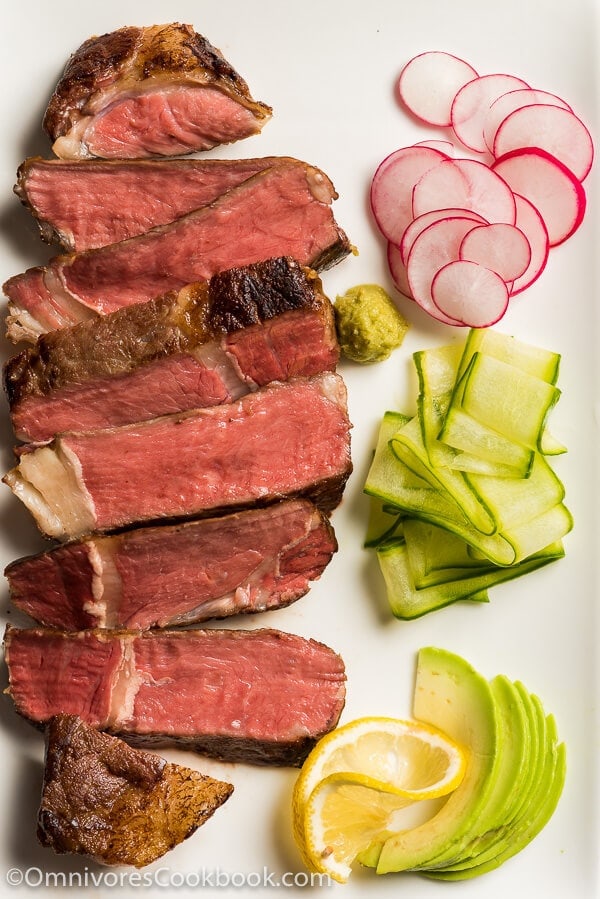
The results
We LOVED how the steaks turned out. As we expected, the beef was juicy, tender, and cooked very evenly with the sous vide method. We cooked the ribeye until medium rare and the New York strip until pink.
I’d say, if you like to have your beef cooked a bit more done than medium rare, you’ll notice a much bigger difference when using sous vide cooking. When it comes to traditional cooking, I usually have my steak cooked rare, otherwise it will taste too dry to me. To my surprise, the sous vide New York Strip tasted great, even though it was cooked until pink.
I created a ponzu dressing using yuzu juice and some vinegar. It was refreshing, zesty and light. I sliced the steak like sashimi, and served it with the dressing. Everything came together perfectly.
Is it worth the time and effort to cook a perfect sous vide steak at home? Drop a comment below and let me know what you think!
[bctt tweet=”Make sous vide steak in your kitchen without special equipment! “]
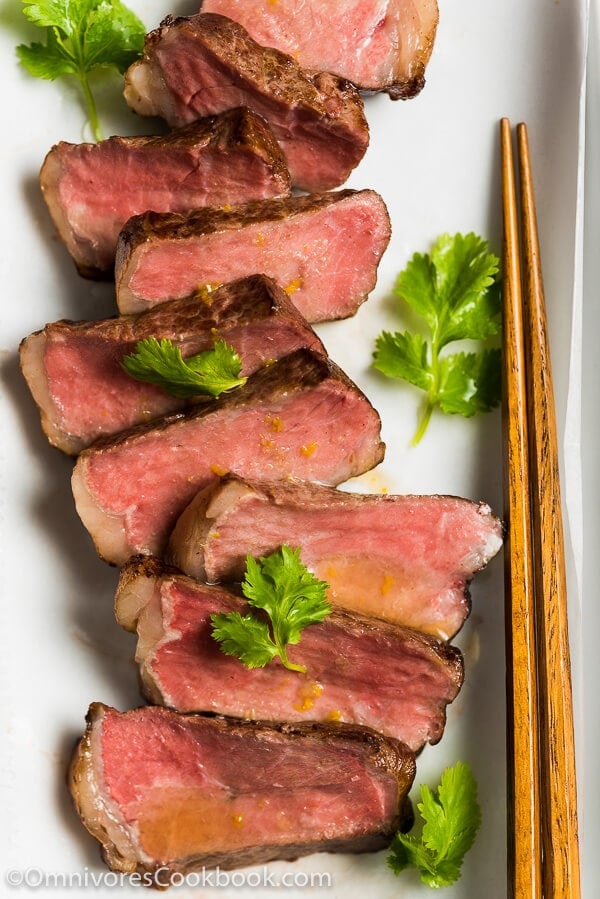
Do you like my recipes? Sign up for Omnivore’s Cookbook’s weekly newsletter to get the latest updates delivered to your inbox and a free e-cookbook! And stay connected via Facebook and Instagram. Thanks for reading and happy cooking!
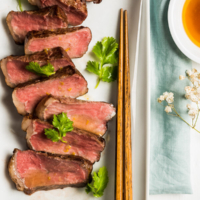
Sous Vide Steak Sashimi with Ponzu Dressing
Ingredients
Ingredients
- 2 beef steaks Ribeye or New York Strip, at least 1 inch / 2.5 cm thick (*footnote 1)
- 4 tablespoons neutral frying oil
- 2 tablespoons unsalted butter
- Sea Salt to taste
- Fresh cilantro leaves to garnish Optional
Ponzu dressing
- 1 tablespoon yuzu juice yield from 2 yuzu fruits (*footnote 2)
- 1 tablespoon rice vinegar
- 1 tablespoon Japanese sake
- 1 teaspoon soy sauce
Special equipment
- Digital thermometer with oven-safe probe
Instructions
- Place the steaks on a small baking tray and transfer them to the freezer. Let sit for 30 minutes, to freeze the exterior.
- Preheat oven to 70 degrees C (160 F) or the lowest temperature on your oven. Place a baking rack on top of a baking tray.
- Heat a heavy skillet (*see footnote 2) over medium high heat until hot. While preheating the skillet, brush oil onto both sides of the steaks.
- Brown the steaks one at a time, 30 seconds per side, until all of each surface turns dark brown. Immediately transfer each steak onto the prepared baking rack once browned.
- Insert the oven-safe probe of the digital thermometer from the side, into the thickest part of the thinnest steak. Set the alarm to the desired temperature - 55 C / 133 F for medium rare, 54 C / 129 F for rare, or 62 C (144 F) for medium.
- Bake until the steak reaches the set temperature. Baking time may vary greatly, depending on the thickness of the steak and on your oven. (*see footnote 3) The residual heat of the meat will continue to cook it after the steaks come out of the oven.
- If your thermometer does not have an alarm setting, stay close to the oven and check the temperature frequently once the temperature is within about 10 C / 18 F of the target temperature, to avoid overcooking.
- Combine all the ingredients for the ponzu dressing in a small bowl. Mix well and set aside.
- After removing the steak from the oven, brush with melted butter and season generously with sea salt. Slice the steak into bite sized pieces, garnish with cilantro leaves, and serve immediately with the ponzu sauce for dipping.
Notes
- In this recipe, I used an 11 ounce (310 gram) New York Strip and a 12 ounce (340 gram) Ribeye.
- If you cannot find yuzu, use 2 teaspoons lemon juice and 1 teaspoon orange juice instead.
- Do not use a nonstick skillet for this. The high heat will damage the coating. I used a cast iron skillet in this recipe.
- Although the cookbook indicated it would take about 50 minutes to cook a 1-inch-thick strip steak, it took me a bit more than 70 minutes. Be sure to judge the doneness only by the core temperature.













The title might state: Sous Vide Steak Sashimi. But Sous Vide was never used!
Maybe author or editor forgot to change an old title?
I re-read recipe and then decided to read entire article.
So I guess we have Sous Vide sans water and Sous Vide…..